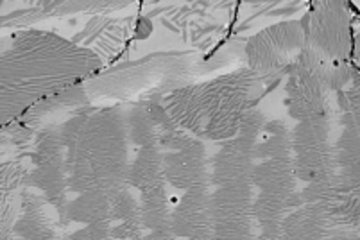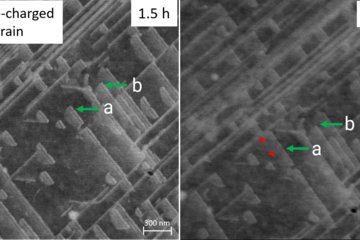All genres
41.
Talk
A Micromechanical Study on the Correlation of Composition and Properties of B2 FeAl across the Interface of an Fe–Al Diffusion Couple. ECR Day, Ruhr Universität Bochum, Bochum, Germany (2024)
42.
Talk
Relationships between local interface chemistry and mechanics probed through in situ micromechanical testing. International Workshop on Materials Behavior at Micro- and Nano-Scale, Xi'an, China (2024)
43.
Talk
Influence of a low angle grain boundary on high strain rate deformation in Copper. MecaNano, Vienna, Austria (2024)
44.
Talk
Boosting mechanical properties of thin film high entropy alloys through nanoengineering design strategies. 16th International Conference on Local Mechanical Properties, Prague, Czech Republic (2024)
45.
Talk
Exploring the links between local interface chemistry and mechanics using in situ micromechanical testing. DPG Spring Meeting of the Condensed Matter Section , Berlin, Germany (2024)
46.
Talk
Influence of the Structure and Chemistry of Σ5 Grain Boundaries on Microscale Strengthening in Cu Bicrystals. TMS Annual Meeting and Exhibition 2024, Orlando, FL, USA (2024)
47.
Talk
Elevated temperature deformation of intermetallic phases in Mg–Al–Ca alloy at small length scale. International conference on creep and fracture of engineering materials and structures, Creep 2024, Bangalore, India (2024)
48.
Talk
Deformation of CoCrFeNi alloy thin films under thermal fatigue. International Conference on Creep and Fracture of Engineering Materials and Structures CREEP 2024, Bangalore, India (2024)
49.
Talk
Using in-situ nano- and micromechanical testing to probe the fracture behavior of intermetallic Laves phase materials. 7th International Indentation Workshop – IIW7, Hyderabad, India (2023)
50.
Talk
Synthesis and characterisation of reactive magnetron sputtered wüstite thin films. European Materials Day 2023, online (2023)
51.
Talk
In situ Mikromechanik an chemischen Grenzflächen. 10. Treffen AG In situ 2D und 3D Charakterisierung, Schwerte, Germany (2023)
52.
Talk
New perspectives for in situ nanomechanics at cryogenic temperatures. FEMS EUROMAT 2023, Frankfurt, Germany (2023)
53.
Talk
Role of temperature on micromechanical fracture behaviour of Laves phase in Mg–Al–Ca ternary alloy. FEMS EUROMAT 2023, Frankfurt, Germany (2023)
54.
Talk
Role of temperature on micromechanical fracture behavior of Laves phase in Mg–Al–Ca ternary alloy. FEMS Euromat 2023, Frankfurt am Main, Germany (2023)
55.
Talk
Deformation mechanism analysis of single crystal hematite Fe2O3 using nanoindentation. FEMS EUROMAT 2023, Frankfurt, Germany (2023)
56.
Talk
Dynamic Testing of Iron-Aluminium Alloy Microparticles Fabricated using a Solid-State Dewetting. FEMS EUROMAT 2023, Frankfurt, Germany (2023)
57.
Talk
Exploring the links between local chemistry and nano-/microscale deformation using in situ testing. ScopeM Seminar, ETH Zürich, Zürich, Switzerland (2023)
58.
Talk
Relating nanoscale structure and properties to macroscale fracture toughness for bulk metallic glasses. 15th International Conference on Fracture, Atlanta, GA, USA (2023)
59.
Talk
Strong and ductile thin film metallic glasses through advanced nanoscale design strategies. COST MecaNano General Meeting 2023, Madrid, Spain (2023)
60.
Talk
Effect of composition and nanostructure on mechanical properties and thermal stability of ZrCuAlx thin film metallic glasses. COST MecaNano General Meeting 2023, Madrid, Spain (2023)











